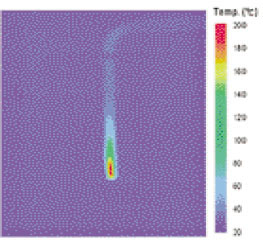Infrared thermographic analysis of temperature rise on the surface of buchanan plugger
Article information
Abstract
This study was performed to evaluate the temperature rise on various position of the Buchanan plugger, the peak temperature of plugger's type and the temperature change by its touching time of heat control spring.
The heat carrier system 'System B'(Model 1005, Analytic Technologies, USA) and the Buchanan's pluggers of F, FM, M and ML sizes are used for this study. The temperature was set to 200℃ which Dr. Buchanan's "continuous wave of condensation" technique recommended on digital display and the power level on it was set to 10. In order to apply heat on the Buchanan's pluggers, the heat control spring was touched for 1, 2, 3, 4 and 5 seconds respectively. The temperature rise on the surface of the pluggers were measured at 0.5 mm intervals from tip to 20 mm length of shank using the infrared thermography (Radiation Thermometer-IR Temper, NEC San-ei Instruments, Ltd, Japan) and TH31-702 Data capture software program (NEC San-ei Instruments, Ltd, Japan). Data were analyzed using a one way ANOVA followed by Duncan's multiple range test and linear regression test.
The results as follows.
1. The position at which temperature peaked was approximately at 0.5 mm to 1.5 mm far from the tip of Buchanan's pluggers (p<0.001). The temperature was constantly decreased toward the shank from the tip of it (p<0.001).
2. When the pluggers were heated over 5 seconds, the peak temperature by time of measurement revealed from 253.3±10.5℃ to 192.1±3.3℃ in a touch for 1 sec, from 218.6±5.0℃ to 179.5±4.2℃ in a touch for 2 sec, from 197.5±3.0℃ to 167.6±3.7℃ in a touch for 3 sec, from 183.7±2.5℃ to 159.8±3.6℃ in a touch for 4 sec and from 164.9±2.0℃ to 158.4±1.8℃ in a touch for 5 sec. A touch for 1 sec showed the highest peak temperature, followed by, in descending order, 2 sec, 3 sec, 4 sec. A touch for 5 sec showed the lowest peak temperature (p<0.001).
3. A each type of pluggers showed different peak temperatures. The peak temperature was the highest in F type and followed by, in descending order, M type, ML type. FM type revealed the lowest peak temperature (p<0.001).
The results of this study indicated that pluggers are designed to concentrate heat at around its tip, its actual temperature does not correlate well with the temperature which Buchanan's "continuous wave of condensation" technique recommend, and finally a quick touch of heat control spring for 1sec reveals the highest temperature rise.





























